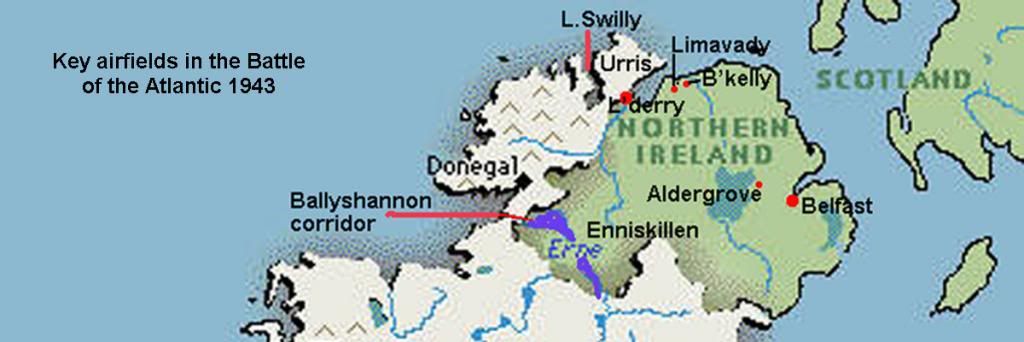 The Ballyshannon corridor over neutral Eire saved RAF flying-boats three to four hours on each sortie from their bases on Lough Erne, avoiding a journey north around Donegal. Northern Ireland had 17 airfields capable of taking four-engined aircraft, including Nutt's Corner and Langford Lodge beside Aldergrove. The first, with Prestwick, were the terminals for Ferry Command from the US, and Langford Lodge became a vast USAF overhaul unit, so big it had its own railway connection to Belfast.
The Ballyshannon corridor over neutral Eire saved RAF flying-boats three to four hours on each sortie from their bases on Lough Erne, avoiding a journey north around Donegal. Northern Ireland had 17 airfields capable of taking four-engined aircraft, including Nutt's Corner and Langford Lodge beside Aldergrove. The first, with Prestwick, were the terminals for Ferry Command from the US, and Langford Lodge became a vast USAF overhaul unit, so big it had its own railway connection to Belfast.
By mid-1940 Britain stood alone against Germany, and Coastal Command’s role in convoy protection became vital. The U-boats were sinking some 50 ships each week, many of them on the convoy route around Ireland. Bodies were being washed ashore in such numbers that Donegal and Mayo councils were concerned at the cost of so many funerals, with coffins at £2.10s each (about £360 in today’s money). Old graveyards, some unused since the Irish Famine of almost a century before, were re-opened for the U-boat victims.
My story centres on Lough Erne, where the Sunderlands and Catalinas began their long hauls into the Atlantic. At first they had to fly north and west around Donegal in neutral Ireland, losing almost four hours of valuable operating time. The Irish Government, protected by the RAF and the Royal Navy and supplied by the Merchant Navy, agreed to permit a low-powered beacon at Ballyshannon, marking a direct corridor across neutral territory for the flying-boats to reach the Atlantic. Today a plaque on the town bridge at Ballyshannon commemorates the airmen who lost their lives on wartime patrol.
Patrols were between eight and 12 hours, the Catalina with extra tanks being capable of 22 hours, its cramped and noisy interior a gruelling workplace for its crew. My friend and instructor Desmond Mock flew the Catalina from Lough Erne in Northern Ireland, and constantly urged me to learn from the mistakes of his wartime days. His patient tuition saved me from at least one disaster.
Desmond quite liked the Cat which he said was pleasant if heavy to handle. With its long wing and wing struts, they tried to keep out of icing conditions. The Cat was cramped for its crew of 10, unlike the spacious Sunderland which even had a well-equipped galley and a magnificent porcelain flush loo in the nose compartment. In fact some airmen slept aboard their Sunderlands at anchor in preference to the damp, freezing nissen huts which housed most of Castle Archdale’s 2,500 staff.
The Cat was very noisy, with the prop blades just behind the cockpit. At high rpm the tips approach sonic speed and create the ear-shattering drone best demonstrated by a Harvard. I met two Catalina pilots in New Zealand in 2001 and both were deaf as a result of four years in Cats. On the other side was the reliability of the Pratt and Whitney Twin Wasp, also used in the Dakota. Desmond told me the legendary Rolls-Royce Merlin was prone to coolant leaks, although nobody dared say so, and he and his comrades much preferred the comforting rumble of the air-cooled radials. “Every aeroplane has its good and bad sides, but we felt the Cat would always get us back provided we could keep off the mountains”.
The Cat had 50-cal waist guns and 30-cal in nose and a ventral mounting behind the hull step. Unlike the Sunderland with its four-gun rear turret, the Cat had little defence against the easiest fighter attack from the rear but such encounters were very rare from Northern Ireland bases and Desmond and his crew never saw an enemy -- “though we certainly didn’t complain about that”.
Eleven hours across the Pacific on comfy seat in the magnificent 747 was more than enough for me, so I can only guess at the stamina needed for 11 hours in a noisy, cramped Catalina. In fact 10 to 12 hour patrols were commonplace, and on one occasion Desmond and his crew were at sea for 22 hours. They were listed as overdue as nobody realised their Cat had long-range tanks, and received a rollicking from the CO for their efforts.